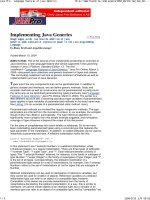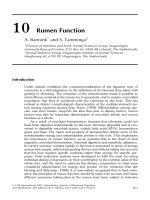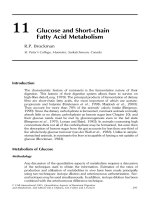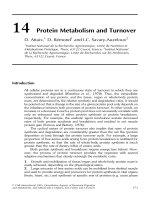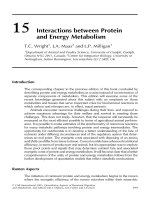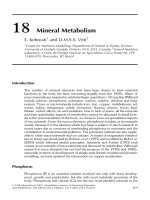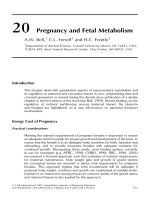Tài liệu AMAZONIAN ACCESSIONS OF WILD HEVEA GERMPLASM - A POTENTIAL SOURCE OF DROUGHT TOLERANCE pptx
Bạn đang xem bản rút gọn của tài liệu. Xem và tải ngay bản đầy đủ của tài liệu tại đây (2.38 MB, 23 trang )
1
A mature rubber plantation
Amazonian accessions of wild
Hevea
germplasm – A potential source of
drought tolerance
M. A. Mercy, D.B. Nair, Meena Singh, T. Meenakumari,
C.P. Reghu and Kavitha K. Mydin
Rubber Research Institute of India, Kottayam – 686 009, Kerala, India
Rubber Board
(Ministry of Commerce & Industry, Government of India)
Email for correspondence:
Introduction
Expansion of
rubber
cultivation from
traditional to
non-traditional
regions in India
2
Introduction contd…
Early detection of stress resistant traits – useful
for the development of location specific clones.
The narrow genetic base of Wickham genepool
and the unidirectional selection for yield limits the
availability of sufficient genetic variability.
1981-IRRDB germplasm collection – a valuable
reservoir of genes for various abiotic stresses.
3
Acre : Brasileia, Feijo, Sena Madureira, Tarauaca, Xapuri
Rondonia – Ariquemes, Calama, Costa Marques, Jiparana, Ouro Preto, Pimenta Bueno, Jaru
Mato Grosso: Aracotuba, Cartriquaca, Itauba, Vila Bella
Provenance No.of
localities
Accessions conserved
S.India N.East Total
Acre 5 1530 242 1772
Rondonia 7 1540 348 1888
Mato Grosso 4 465 382 847
Total 16 3576 972
4548
Provenance-wise conservation- India
Introduced into India from 1981 – 1990 through
Malaysia
4
Objective of the study
To identify the drought tolerance potential of
Amazonian accessions using various
morphological, physiological, structural
and biochemical parameters related to
drought tolerance.
-
traditional region
- hot spot
Effect of moisture stress on plant growth
5
Drou
g
ht affected accession
Sun scorching in the leaves
6
7
Morphological Characters
Scion height (cm)
Scion basal diameter (mm) at 20 cm
from the bud union
Number of leaves
Number of leaf flushes per plant
Inter-flush distance (cm)
Single leaflet area (cm2)
Specific leaf weight (SLW)
Observations
Morphological parameters of selected accessions
Genotypes Plant height
(cm)
Basal diameter
(mm)
No. of
flushes
No. of
leaves
Inter flush
distance
(cm)
Single leaflet
area (cm
2
)
SLW
(g cm
-2
)
AC 1044 102.79
c
11.14
ab
2.08
cd
49
d e
28.05
ab
84.42
a
0.005
a
MT 55 147.06
a
13.23
ab
3.06
abc
90.89
abc
28.77
ab
87.05
a
0.006
a
AC 446 115.77
abc
13.49
ab
2.83
abcd
48.47
de
35.26
ab
86.84
a
0.005
a
RRIM 600 104.95
c
11.61
ab
2.28
bc d
51.44
de
22.67
b
58.82
b
0.006
a
Tjir 1 104.9
c
11.89
ab
2.61
bc d
70.92
abcd
22.18
b
59.30
b
0.007
a
MT 41 144.53
ab
12.88
ab
3.81
a
99.72
a
24.07
b
83.08
a
0.006
a
MT 76 144.06
ab
12.02
ab
3
abc
77.22
abcd
28.59
ab
60.85
b
0.006
a
MT 66 99.75
c
13.63
ab
2.69
bc d
48.25
de
19.57
b
81.56
a
0.007
a
MT 938 130.67
abc
11.5
ab
2.17
cd
60.33
bc de
43.92
a
84.8
a
0.006
a
AC 650 123.68
abc
15.79
a
3.36
ab
95.25
ab
32.51
ab
83.22
a
0.007
a
AC 652 99.22
c
10.14
b
1.78
d
33.45 21.72
b
80.44
a
0.006
a
RRII 105 108.31
bc
11.66
ab
2.25
bc d
50.08
de
20.15
b
61.52
b
0.007
a
AC 728 112.29
abc
13.1
ab
2.33
bc d
55.44
cde
24.47
b
90.78
a
0.005
a
G mean 118.31 12.47 2.64 63.88 27.07 76.784 0.006
Any two means having a common letter are not significantly different
8
Morphological characterization based
on drought sensitive parameters
- leaf size
- appearance of leaf surface
- presence or absence of wax coating
on leaf surface
- leaf yellowing and senescence
- vigour of plant
Accn. Leaf
size
Leaf
surface
Wax
coat
Yellowing
(%)
Vigour Senesce
nce (%)
MT1631 Narrow
Flat Nil 37.5 Low 100
MT 1710 Narrow
Curved Nil 10 Medium 80
AC 462 Narrow
Flat Nil 68.33 Medium 100
MT 3714 Narrow
Curved Nil 100 Medium 84
AC 441 Narrow
Flat Nil 100 Medium 100
MT 81 Broad
Flat Nil 13.75 Medium 8.33
MT 200 Broad
Flat Nil 61.25 High 45
RO 217 Narrow Flat Nil 40.0 High 34
RO 1520 Broad Flat Nil 88 Low 86
Morphological characterization based on drought sensitive parameters
Contd….
9
Acce
ssion
Leaf size Leaf
surface
Wax
coat
Yellowi
ng (%)
Vigour Senesne
nce (%)
MT
1623
Narrow
Curved Nil 7.5 High 0
MT
1681
Narrow
Curved Nil 12.5 High 7.0
MT 52 Narrow Flat Nil 50.0 Low 54
MT
4242
Narrow Flat Nil 42.0 Medium 42
MT 60 Broad Flat Nil 76.25 Medium 80
MT 48 Broad Flat Nil 63.0 Medium 68
MT
1584
Broad Flat Nil 42.0 Medium 50
RRII
208
Broad Flat Nil 43.0 Medium 52
RRIM
600
Narrow/Small Flat Nil 48.0 High 47
Tjir 1 Narrow/small Flat Nil 61.25 Medium 55
RRII
105
Narrow/small Flat Yes 100.0 Medium 100
Contd
Physiological parameters :
- Chlorophyll fluorescence parameters
- Leaf water potential (under water stress )
10
Ranking of germplasm accessions (top ten) based on
percent inhibitions in dark Fv/Fm, quantum yield and
Fv’/Fm’.
Rank
No.
Fv/Fm Quantum Yield Fv’/Fm’
1 MT 4713 MT 4859 MT 4787
2 RO 4580 RO 4913 AC 4833
3 MT 4856 AC 4689 MT 4772
4 MT 5100 MT 4788 MT 5152
5 MT 4772 MT 4856 MT 4856
6 MT 5078 MT 4756 MT 5100
7 MT 4802 MT 5078 MT 4713
8 MT 4788 MT 5100 MT 4788
9 MT 5152 MT 5089 AC 4689
10 MT 5114 MT 4747 MT 5078
The chlorophyll fluorescence parameters and
percentage inhibitions in top ranking clones.
Sl.No. Accession % inhibition
in Fv/Fm
% inhibition
in Q.Y.
% inhibition
in Fv’/Fm’
Top ranking germplasm accessions
1 MT 5100 6.0 4.3 4.2
2 MT 5078 12.6 4.5 7.6
3 MT 4788 10.0 8.8 10.7
4 MT 4856 14.0 10.0 20.0
Bottom ranking germplasm accessions
1 MT 4694 54.0 37.0 47.0
2 RO 4615 30.0 30.7 24.5
11
Clonal variation in PS II quantum yield due to
drought treatment
(C- control, S- drought stressed)
Clones PS II quantum yield %Reduction
__________________________________________
RRII 105 C 0.594 ± 0.01
S 0.349 ± 0.03 41.2%
RRIM 600 C 0.533 ± 0.03
S 0.447 ± 0.01 17.0
MT 4788 C 0.486 ± 0.01
S 0.404 ± 0.01 11.0
MT 5100 C 0.569 ± 0.02
S 0.443 ± 0.03 22.5
MT 4694 C 0.582 ± 0.01
S 0.393 ± 0.04 32.5
__________________________________________
Clonal variation in mid-day leaf water potential after
drought treatment (C- control, S- drought stressed)
Clones Mid-day leaf water %Reduction
Potential (-MPa)
__________________________________________________
RRII 105 C 2.4 ± 0.86
S 3.0 ± 0.40 25.2
RRIM 600 C 2.3 ± 0.58
S 2.7 ± 1.10 15.4
MT 4788 C 2.3 ± 0.53
S 2.9 ± 0.93 26.3
MT 5100 C 2.4 ± 0.31
S 2.8 ± 0.74 17.0
MT 4694 C 2.4 ± 1.03
S 2.9 ± 0.92 22.4
__________________________________________________
12
AN Leaf water
potential (-Mpa)
(April )
MT 3714 (-2.27)
MT 1631 (-2.4)
MT 48 (-2.67)
MT 1681(-2.93)
MT 1584 (-3.06)
RRII 208 (-3.07)
Tjir 1 (-3.34)
RRIM 600 (-2.8)
RRII 105 (dried)
CD= 0.35 **
** Significant at 1%
Clonal variation in afternoon leaf water potential
Percent leaf yellowing and senescence (ranges) of top,
middle and bottom ranking accessions selected from
source bush nurseries (SBN) by empirical scoring
Germplasm
Nursery
Yellowing (%) Senescence (%)
Top Middle Bottom Top Middle Bottom
SBN 2003
0 -5 14 -15 25 -40 0 -1 10 -15 20-40
SBN 2004
0 -15 40 -45 60 -85 0 -1 15 -20 80 -90
SBN 2005
0 -10 30 -35 50 -80 5 -30 49 -50 75 -90
SBN 2006
10 -14 39 -40 80 -90 10 -35 50 -55 90 -95
SBN 2007
0 -15 40 -50 50 -100 10 -30 49 -50 80 -100
SBN 2008
5- 15 40 -50 70 -90 10 -30 50 -60 70 -100
13
Germplasm
Nursery
Total no. of
accessions
Drought
tolerant
accessions
Drought
susceptible
accessions
SBN 2003
588 70 11
SBN 2004
976 49 30
SBN 2005
700 16 33
SBN 2006
806 11 32
SBN 2007
500 12 12
SBN 2008
202 7 3
Total 3772 165 121
No. of wild accessions selected from
germplasm source bush nurseries for
intrinsic tolerance to drought stress
Structural parameters :
Leaf
- Stomatal density- Number of stomata
per mm2 in the abaxial surface
- Thickness of palisade tissue (µm)
- Thickness of mesophyll tissue (µm)
- Mean number of cells in unit length of
the palisade layer
- Leaf lamina thickness ( µm)
- Leaf vein (midrib) diameter (mm)
Stem
- No. of primary xylem points and intra xylary phloem
(from one year old twig)
14
Accessions No. of
stomata per
mm
2
Leaf
thickness
(
m)
Midrib
diameter
(
m)
Palisade
tissue
thickness
(
m)
Mesophyll
tissue
thickness
(
m)
Palisade no.
per unit
length
AC 1044 450.98
ab
123.93
abc
438.90
a
54.63
bcde
104.27
abcd
34.26
ab
MT 55 389.98
abcd
105.77
fg
310.67
g
48.04
efg
86.35
ef
28.60
de
AC 446
276.69
d
117.90
bcde
371.00
bcd
47.73
efg
84.95
f
30.22
bcd
RRIM 600 356.67
abcd
123.77
abc
352.20
defg
51.36
cdef
105.79
abc
35.24
a
Tjir 1 446.62
ab
129.83
a
406.80
ab
64.65
a
114.52
a
24.29
f
MT 41 333.33
bcd
104.23
g
360.73
cde
44.14
fg
82.67
f
33.51
abc
MT 76 357.30
abcd
127.83
a
346.48
defg
59.37
abc
102.78
abcd
31.19
abcd
MT 66 481.48
a
109.43
efg
419.53
a
48.31
efg
88.50
def
34.59
a
MT 938 296.29
cd
121.50
abcd
311.90
fg
42.42
g
101.38
abcde
33.47
abc
AC 650 331.16
bcd
114.43
cdef
355.18
def
50.43
defg
95.65
bcdef
29.76
cde
AC 652 348.58
abcd
127.70
a
312.93
fg
62.31
ab
109.79
ab
33.40
abc
RRII 105 427.01
abc
127.27
ab
400.20
abc
58.08
abcd
107.26
abc
32.38
abcd
AC 728 394.34
abcd
113.73
def
318.67
efg
51.64
cdef
92.47
cdef
26.04
ef
Mean 376.19 119.03 361.94 52.5 98.18 31.3
Variability for leaf structural characters of selected
accessions of Hevea brasiliensis
Transverse section of one year old twig of wild Hevea accession
MT 1623 having maximum number of IXP
IXP
PX
X 16
X 4
15
Transverse section of one year old twig of wild Hevea accession
IXP
X 16
MT 1623
Transverse section of one year old twig of wild Hevea accession
MT 1584 having minimum number of IXP
X 4
X 16
16
Accession/
Clone
No. of primary
xylem points
(PXP)
No. of
intraxylary
phloem points
(IXP)
Diameter
of twig
(mm)
IXP/ mm
diameter
of twig
MT 1623 104.50 77.00 15.60 4.94
MT 200 81.80 75.38 20.30 1.82
MT 3714 74.25 59.25 17.90 3.31
MT 48 54.67 38.79 12.80 3.03
Tjir 1 60.83 30.67 12.50 2.45
RRII 105 48.60 38.20 9.00 4.24
RRII 208 56.00 39.88 11.90 3.35
RRIM 600 57.48 49.15 7.70 6.38
CD **
30.15 30.40 3.88
CV 26.53 42.04 15.08
** Significant at 1%
Potential accessions for structural traits along with twig diameter
Biochemical parameters:
- chlorophyll content
- chlorophyll stability
- wax content
- cell membrane stability
17
Clonal variation in leaf chlorophyll content after
drought treatment (C- control, S- drought stressed)
__________________________________________________
Clones Chlorophyll content %Reduction
(mg/g/fw)
__________________________________________________
RRII 105 c 3.67 ± 0.09
S 2.78 ± 0.09 24.5
RRIM 600 C 3.12 ± 0.16
S 2.86 ± 0.03 8.8
MT 4788 C 2.97 ± 0.11
S 2.40 ± 0.13 19.1
MT 5100 C 3.31 ± 0.16
S 2.95 ± 0.12 10.8
MT 4694 C 3.63 ± 0.25
S 2.85 ± 0.07 21.4
__________________________________________________
3.1
3.15
3.2
3.25
3.3
3.35
3.4
MT AC RO
Accessions with
high chlorophyll
content
Accessions with low
chlorophyll reduction
Accessions with high
wax content
RO 4599 MT 5131 RO 5062
MT 4878 RO 5072 RO 4599
MT 5090 RO 4595 RO 4620
AC 4939 RO 5004 RO 4595
RO 5163 AC 4676 RO 5044
RO 5162 AC 4939 RO 5022
MT 4740 MT 5141
MT 5093 MT 4704
MT 5098 MT 4740
MT 5100 MT 4870
MT 5156 MT 5093
RO 5163 MT 5098
MT 5100
MT 5156
Potential accessions identified for various biochemical parameters
18
Accessions % injury Accessions % injury
AC 4677 27.1
MT 5125 19.6
RO 5047 25.6 MT 4740 23.6
MT 4694 17.9 MT 5093 20.3
MT 4878 55.5 RO 4595 32.4
RO 5023 66.6 RO 4620 42.1
AC 4833 55.7 RRII 105 36.9
MT 5156 67.1 RRIM 600 18
CD = 8.95 **
** - Significant at P = 0.01
Variation for cell membrane injury among the
selected accessions
Screening at hot-spot
(RRS, Dapchari)
Maharashtra state in W.India
Weather conditions at RRS, Dapchari
- a drought- prone region experiencing high
temperature (exceeding 40
o
C in April)
- high light intensity
- very low soil moisture during summer months.
- rainfall pattern limited only to four months in a year
- average annual rain fall of 7.5mm per day
- average of 90 rainy days/ year.
19
Characters Minimum
(Accession)
Maximum
(Accession)
General
.Mean
CD
(P=0.05)
Check clones
(Mean)
RRII
105
RRIM
600
Tjir 1 RRII
208
Height (cm) 90.0
(AC 4861)
304.0
(RO 2387)
213.78 60.71 162.74 227.44 170.50 197.35
Girth (cm) 3.14
(RO 1322)
8.16
(MT 1697)
6.32 1.3 5.25 5.99 5.06 5.49
No.of whorls 1.0
(MT 195)
5.6
(RO 3660)
3.33 0.92 3.62 4.64 3.78 3.89
No. of leaves 12.0
(MT 195)
71.2
(MT 1623)
42.33 16.87 41.17 62.4 53.44 52.76
No. of leaves
fallen
23.0
(RO 1322)
167.0
(RO 93)
46.86 18.25
41.02
47.1 44.38 54.73
Senescence
(%)
32.74
(MT 4222)
77.37
(RO 93)
52.44 12.86 49.70 42.83 45.27 49.63
First year post- drought data on range and mean of growth
characters in the hot-spot region
Drought tolerant and susceptible accessions
20
Accession Test tap yield
(g)of10
tappings
Accession Test tap yield
(g)of10
tappings
RO 1769 33.34 MT 62 11.06
RO 2976 21.67 RO 3626 11.05
AC 173 15.14 MT 1660 9.47
MT 915 14.72 RRII 105 21.99
MT 2229 11.09 RRIM 600 24.08
CD(P=0.05) 13.31
Potential accessions with good juvenile yield
in the hot-spot
Set
no.
Accession Drought tolerant attribute
I MT 54 Good height, girth, number of whorls, RWC and stable performance
MT 1579 Good growth even after experiencing stress
MT 67 Good growth (height and girth), RWC
MT 1668 No.of leaves, good growth (height and girth) and girth increment
MT 1616 No.of leaves, no. of whorls, RWC, good growth (height and girth)
MT 1627 No.of leaves, no. of whorls, RWC, good growth (height and girth)
MT 1649 Good growth even after experiencing stress
MT 80 Good growth increment and RWC even after experiencing stress
II MT 41 Good foliar production, good RWC , higher rate of girth increment
RO 1248 Good growth (height and girth), good RWC in post drought period
AC 765 Good growth (height and girth, no. of whorls and leaves)
RO 2524 Good growth (height and girth, no. of whorls)
MT 945 Good growth (height and girth, no. of leaves)
MT 58 Good growth (height and girth, no. of leaves)
List of wild accessions identified after screening in
hot-spot region
21
Mature yield of Amazonian accessions
At RRS, Padiyoor (Northern Kerala)
- summer period (February- May)
- temperature 35
0
C
- rainy days 122/yr.
- high evaporation ( 5- 6 mm/day)
Accessions Summer
season yield
(g/t/t )
Total yield
( g/t/t)
% of the
yield of RRII
105
5
th
yr. 5
th
yr. 5
th
yr.
AC 166 46.03 56.08 91.20
MT 1020 18.00 26.97 43.00
MT 179 14.37 23.57 38.00
RO 2908 16.48 43.78
71.00
AC 675 13.89 26.09 42.00
RO 2385 15.24 32.57
52.80
AC 655 20.45 30.80 50.00
AC 2004 23.44 34.86 56.70
MT 54 15.49 20.37 33.00
AC 670 28.29 40.78
66.00
RRII 105 41.18 62.27
CD( 5%) 10.91 14.78
Accessions with good mature yield at RRS, Padiyoor
22
Accessions with good Timber yield
AC 661
MT 941 AC 650
Drought related
parameter/
location
Potential Accessions identified
Morphological MT 55, AC 650, MT 66, MT 41, AC 650,MT 76, AC 652, MT 938
Drought adaptation MT 1681, MT 1623
Chlorophyll
fluorescence
MT 5100, MT 5078,MT 4788, MT 4856
Leaf water potential MT 4788, MT 5100, MT 3714, MT 1631, MT 48
Structural (leaf) AC 446, MT 938, MT 41, AC 1044
Structural (stem) MT 1623
Biochemical MT 5156, MT 5100, RO 5163, MT 4740, AC 4939, RO 4595, RO 5004, RO 4599, MT
5093, MT 4788
Non traditional
region
MT 54, MT 1579, MT 67, MT 1668, MT 1616, MT 1627, MT 1649, MT 80, MT 41, RO
1248, AC 765, RO 2524, MT 945, MT 58, MT 1668, MT 1681, MT 1710, RO
2387,RO 2153, RO 85, MT 4788
Yield (non
traditional)
RO 1769, RO 2976
Yield (traditional) AC 166, MT 1020, MT 179, RO 2908, AC 675
Highlights from various studies
23
Conclusions
Genetically divergent Amazonian accessions are an
excellent repository of genes imparting tolerance to
abiotic stress.
A potential source for drought tolerant accessions.
Of the three provenances, accessions from Mato
Grosso are the most promising for developing
drought tolerant clones.
Thank you all
